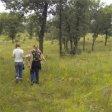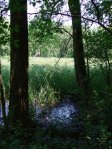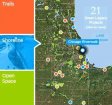Ongoing Initiatives
Calumet-Sag Trail
Federal, state and local intergovernmental collaboration and community support crystallized for the 26-mile Calumet-Sag Trail during the Burnham Plan Centennial. The trail runs through 14 communities in Chicago’s south and southwest suburbs following the Cal-Sag Channel, a major shipping route connecting the Chicago Sanitary and Ship Canal with Calumet Harbor and Lake Michigan. [MORE]
Des Plaines River Trail/Liberty Prairie Reserve Connection
Lake County Forest Preserves
Planning efforts by the Lake County Forest Preserve District are focused on fixing a key gap in the regional trail system by creating a new trail connection linking the 32-mile Des Plaines River Trail with the 5,800-acre public-private Liberty Prairie Reserve in the Grayslake area. This link will make possible a later connection to the 35-mile Millennium Trail, now under development. [MORE]
Last Four Miles
Friends of the Parks
With extensive community participation and solid technical support, Friends of the Parks has developed and proposed an award-winning, visionary and practical plan for completing the last four miles of gaps in Daniel Burnham’s vision of uninterrupted public access along Chicago’s entire 30-mile shoreline from Evanston to Indiana. This strategic, long-term project will achieve four of the five Green Legacy goals: completing our region’s trail system, expanding neighborhood green space, protecting our shoreline, and preserving regionally significant open spaces.
Midewin National Tallgrass Prairie
Midewin National Tallgrass Prairie
Midewin is the largest protected open space in the Chicago metropolitan region and the largest grassland restoration ever initiated east of the Mississippi River. 19,000 acres of native tall-grass prairie are being preserved and restored. Midewin’s sweeping landscape on the former site of the Joliet Arsenal 40 miles southwest of Chicago, is in one of the region’s fastest-growing counties. Now owned and managed by the US Forest Service, it will be a tremendous natural asset for neighboring communities and the metropolitan area as a whole.
Bloomingdale Trail
Trust for Public Land
The Bloomingdale Trail is one of only a handful of innovative projects in the world that creates new open space in a dense urban neighborhood on abandoned elevated rail lines. Only the second project of its type in the nation and the first in Chicago, the trail runs from the Chicago River to Ridgeway Avenue. Design and engineering are underway on this 2.8-mile linear park located on an above-grade right-of-way on Chicago’s northwest side. [MORE]
Englewood Open Space Plan and New E.R.A. Trail
Openlands
A community-wide planning process at the grassroots level in Chicago’s south side Englewood neighborhood has undertaken a comprehensive plan to combine public open space amenities with green development. This multi-objective initiative is an outstanding example of the Centennial’s Green Legacy Projects because it expands neighborhood green space, adds to the region’s trail system and uses green infrastructure to renew a neighborhood’s environment and spirit. [MORE]
Burnham Greenway Gap
Illinois Department of Natural Resources
Of all the Green Legacy projects, perhaps none could be more productive in bringing together unconnected green infrastructure than closing the Burnham Greenway gap—the missing link in a crossroads of several trails of regional, state and national significance. This keystone location of strategic importance is a two-mile gap in the 11-mile Burnham Greenway, a former railroad right-of-way linking Chicago to Lansing. Closing the Burnham Greenway gap is a major Green Legacy goal and creates a hub tying together hundreds of miles of local, state and inter-state trails. [MORE]
Old Plank Road Trail
Forest Preserve District of Will County
In the works for years, the 21-mile Old Plank Road Trail into Joliet was finally completed during the Centennial by the Forest Preserve District of Will County. It connects to Joliet’s municipal bikeway system, which, in turn, connects to the Illinois & Michigan Canal Trail. This exemplifies the Green Legacy approach by closing a critical gap in the Grand Illinois Trail, thereby giving Joliet and many other neighborhoods and communities new connections to rivers and streams and better access to nearby forest preserves and parks. [MORE]
Heritage Park
Forest Preserve District of Will County
The Heritage Park Plan is a vision that weaves together an eight-mile corridor of green infrastructure features along the Des Plaines River and Illinois and Michigan Canal from Isle a la Cache (135th Street) through Lockport and into downtown Joliet. This plan advances the Green Legacy goal of connecting us to our rivers and streams. Another part of the plan meets the Green Legacy goal of preserving regionally significant open space through this year’s opening of Lincoln Landing.
Kankakee Sands
The Nature Conservancy
This Burnham Plan Centennial Green Legacy Project has helped enhance local pride in a bi-state region that contains one of the rarest ecosystems on earth—the landscapes at the south end of Lake Michigan where sand and water shifted through the millennia to create rich environments for nature and wildlife. Tens of thousands of acres of sand prairie, savanna and marsh lands originally comprised the Kankakee Sands region, which spans the Indiana–Illinois border and generally follows the Kankakee River.
Kankakee Riverfront Trail
Community Foundation of Kankakee River Valley
Phase I of the Kankakee Riverfront Trail was begun—and will be completed—during the Centennial. The 6.5 mile-long trail will enhance local access to the Kankakee River and connect the city of Kankakee with Kankakee River State Park. This project advances three Green Legacy goals: connecting us to our rivers and streams, completing our regional trail system and expanding neighborhood green space.
[MORE]
Marquette Greenway Trail
Northwestern Indiana Regional Planning Commission
The 50-mile Marquette Greenway Trail will eventually link communities, major parks and a wide variety of cultural, natural and economic assets. The Northwestern Indiana Regional Planning Commission and the Indiana Department of Natural Resources’ Coastal Program, in conjunction with the Northwest Indiana Regional Planning Association, announced on October 29 a plan to close a nine-mile gap separating two units of the Indiana Dunes National Lakeshore. This will contribute to the Green Legacy goals of preserving regionally significant open space and completing our trail system. [MORE]
Chicago Riverfront Trail
City of Chicago
On June 19, 2009 the City of Chicago opened the first section of the Chicago Riverwalk—between Michigan Avenue and Wabash Avenue and under the Michigan Avenue bridge. By retrofitting the riverfront to give pedestrians direct river access and green space in the heart of downtown, Chicago’s Green Legacy Project is advancing the next generation of public shoreline—the river’s edge—to provide health and recreation as well as aesthetic and economic development benefits.
Calumet Open Space Reserve
City of Chicago
Chicago’s Calumet Open Space Reserve Plan is a blueprint for habitat restoration, recreation and trail connections on Chicago’s southeast side, covering 4,800 acres of one of the largest and most diverse natural wetland complexes in the Midwest. It intends to reverse decades of disinvestment and pollution in an urban location where high quality natural areas contrast with the “edgy” landscape of the region’s industrial past.
Openlands Lakeshore Preserve
Openlands
The Openlands Lakeshore Preserve on Lake Michigan at the former Fort Sheridan in Highland Park opened to the public for the first time in a century in September 2009. Because Illinois has only 60 miles of Lake Michigan shoreline, adding a 3/4 mile long ravine and a mile of undeveloped lake bluffs and shoreline—both with spectacular views—is a major milestone for our region’s permanent green infrastructure. When completed, the Preserve will provide access via a bluff trail for hiking, biking and wheelchair access, a shoreline walk and a ravine trail. [MORE]
Deer Grove Preserve
Forest Preserve District of Cook County
The Forest Preserve District of Cook County was created, in part, to carry out the Burnham Plan’s call for protecting valuable natural areas for future generations. The very first land acquired in 1916 was 500 acres of the west side of Deer Grove Forest Preserve. By the time of the Plan’s Centennial in 2009, the Preserve had expanded to include 1,800 acres of mixed upland savanna, grassland and wooded wetlands. [MORE]
Waukegan Open Space
City of Waukegan
Waukegan’s plan for transforming its downtown and lakefront is like a modern-day Burnham Plan. [MORE]
Hack-ma-tack National Wildlife Refuge
Openlands
Creating a new national wildlife refuge of up to 10,000 acres spanning the Illinois-Wisconsin state line in the rapidly developing northwest part of the metropolitan area would dramatically advance the Green Legacy goal of preserving regionally significant open space. This bi-state area is home to a dramatic glacial landscape and to an extraordinary collection of diverse aquatic and terrestrial communities.
Midewin Tallgrass Prairie: Requests for Prairie Learning Center Designs
Midewin National Tallgrass Prairie
The Burnham Centennial provides the context and a timely opportunity to seek out new and innovative ideas for making the tremendous resources of the Midewin National Tallgrass Prairie available to the diverse Chicago community in ways that enhance both our natural environment and the region’s quality of life. Chicago professionals have the opportunity to design a Burnham Plan Centennial at Midewin in southwestern Will County. The project consists of two separate but integrated open-air, visitor/education areas. [MORE]
Rock Run Greenway
Forest Preserve District of Will County
Theodore Marsh—the last unprotected gap in the nine-mile Rock Run Greenway in the Joliet-Lockport area—was acquired during the Centennial by the Forest Preserve of Will County. This acquisition achieves two Green Legacy goals: preserving regionally significant open space and completing our regional trail system. Rock Run consists of 1,200 acres of high quality wetlands and uplands interconnected by a greenway trail that forms a loop connecting to the I&M Canal Trail and the Grand Illinois Trail.
[MORE]
Northeastern Illinois Regional Water Trails Plan
Openlands
The Centennial year commemorates the completion of nearly 90 percent of the 500-mile Northeastern Illinois Regional Water Trails Plan. The Plan was developed by Openlands, Northeastern Illinois Planning Commission (NIPC), Illinois Paddling Council and the Illinois Department of Natural Resources. It was adopted by NIPC in 1999.
[MORE]
Fox River Trail
City of Aurora
One of the Burnham Plan Centennial principles for green infrastructure is to connect us to our rivers and streams. Another Green Legacy goal is to complete our region’s trail system. Aurora’s downtown development plan will accomplish both through the creation of RiverEdge Park that will close a downtown gap and complete an uninterrupted 60-mile trail. Great progress has been made during the Centennial toward the closing of the last gap in this green-infrastructure trail that runs the length of Kane County, and through McHenry County to Wisconsin.
Green Legacy Projects
Our region’s communities are connected through a network of open spaces and natural areas in what is called the green infrastructure. The Burnham Plan Centennial Committee, with the nonprofit organization Openlands, identified 21 Green Legacy Projects to close critical gaps in this infrastructure and continue to expand the green vision of the Plan of Chicago, realizing Burnham’s vision for a region-wide system of parks and open space. [MORE]
























